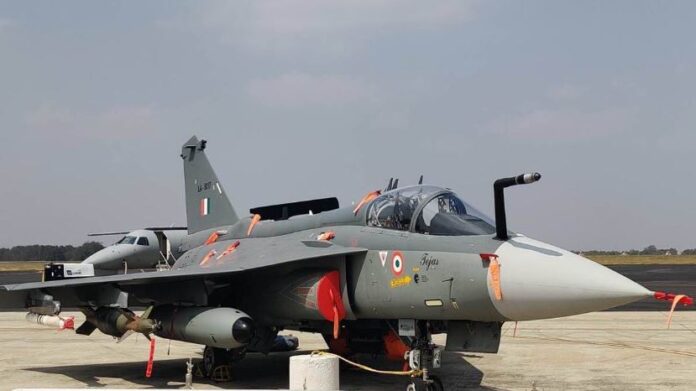India’s aerospace sector is in full swing with developments such as groundbreaking by Tata-Airbus for the construction of the C295 military transport aircraft.
Garuda Aerospace has signed an agreement with Lockheed Martin to integrate the latter’s advanced software with the former’s range of drones for commercial and defense purposes.
Being the largest importer of defense, India has shifted its strategy in the defense and aerospace (A&D) sector towards “Make-in-India” and has further envisioned itself as a global manufacturing hub with “Make-in-India for the World». This policy has resulted in an indigenous aircraft carrier with more than 75% indigenous content and a light combat aircraft with more than 60% indigenous content.
Atmanirbharta, AMCA and a lost engine
The push for indigenization builds on a successful cooperative manufacturing and technology transfer strategy in which foreign Original Equipment Manufacturers (OEMs) partner with their Indian counterparts – public and private – to manufacture in India for defense needs. Indian. In this way, existing markets are served and research and development in the country is encouraged. A stellar example is the Indo-Russian BrahMos supersonic cruise missile.
In this commitment to indigenization, a key missing component in the puzzle has been the engine. The manufacture of modern aircraft engines has been a closer secret than nuclear technology.
A select few companies are present throughout the world, and virtually no one else is capable of making an engine indigenously. Hindustan Aeronautics Limited (HAL) has been unable to manufacture a single low-thrust engine on its territory. Therefore, it sought foreign OEMs to provide an engine for the Tejas Light Combat Aircraft (LCA).
However, “foreign OEMs are fraught with international political considerations. So when HAL wanted a GE F414 engine that would put out about 100kN of thrust, he settled on a GE F404 engine with only 80kN of thrust. For the LCA Tejas Mark II, the GE F414 engine is likely to be incorporated. However, this will further detract from the power of the Mark II variant, which could have carried more payload and flown further,” Girish Linganna, an aerospace and defense analyst, told Financial Express Online.
In the midst of all this, India’s fifth-generation aircraft program, Advanced Medium Combat Aircraft (AMCA), is underway. For the AMCA, UK-based Rolls Royce is expected to partner with the Defense Research and Development Organization (DRDO) to jointly develop engines for this aircraft.
“Jet engines contain more than 30,000 moving parts and require input from other industries such as metalworking, forging, foundry, and machining. This complexity is a bottleneck for anyone looking to develop an engine on their own,” says Linganna.

Made in India Engines
With defense exports boosted and sufficient national interest in state-of-the-art defense equipment, India is now in talks with various engine manufacturers to jointly develop an engine for the AMCA.
British engine manufacturer Rolls Royce and American Pratt and Whitney have submitted a similar offer. Even Indian companies like Tata plan to work with GE in a joint venture to offer an engine to HAL. Tata is already developing various engine components for various Leading Edge Aviation Propulsion (LEAP) engines.
“Global South feels the pain” says Jaishankar as Ukrainian conflict dominates Indo-Russian talks ahead of G20
According to Linganna, “AMCA’s engine dilemma has inadvertently turned India into a battleground for engine manufacturers. With a co-development model, manufacturers will earn a piece of the AMCA pie and any further development. HAL also intends to develop the engine of the Hindustan Turbo Trainer 40 (HTT 40) indigenously. Annually, HAL plans to develop 170 aircraft, including exports.”
The Future of Flyers: The World Aerospace Forecast
It is estimated that the domestic aviation market in India will contribute more than 30,000 million dollars annually to the Gross Domestic Product (GDP). It is already the third in domestic traffic, and it will also be the third national market.
In this commitment to indigenization, a key missing component in the puzzle has been the engine. The manufacture of modern aircraft engines has been a closer secret than nuclear technology.
The government is pushing for increased air connectivity and is expected to build an additional 100 airports by 2024 under the UDAN plan. This means, according to information available in the public domain, that the number of passengers will rise to more than 500 million, and that the fleet will number 2,500 aircraft in the 2040s.
Maintenance, repair and overhaul (MRO)
With the rise of the domestic industry, major manufacturers are realizing the geographical and technological potential of India. Therefore, most manufacturers have announced the location of maintenance, repair and overhaul (MRO) facilities for their aircraft, with the intention of making India the regional hub.
The American company Boeing launched the Boeing India Repair Development and Sustainability (BIRDS) program in 2021 with the intention of turning India into a regional MRO hub. It has partnered with Indian MSMEs such as Air Works and Air India Engineering Services Limited (AIESL) to provide maintenance and repair services for various Boeing aircraft in service with the Navy and Air Force.
Last year, the Ministry of Civil Aviation launched a maintenance and repair policy that was a great boost for these companies. The policy included leasing land through public tenders, reducing the fees charged by the Airports Authority of India (AAI) for maintenance operations and extending the award period from 3-5 years to 30 years.
This means, according to information available in the public domain, that the number of passengers will rise to more than 500 million, and that the fleet will have 2,500 aircraft in the 2040s.
The aim of this policy is to make India a global ‘hub’. The increased ease was aimed at curbing the practice of domestic aircraft flying to the Middle East for cheaper MRO.
The French company Safran has already carried out a similar co-production with HAL for the Shakti helicopter engine. The Shakti engine powers the latest attack helicopter, the Light Combat Helicopter (LCH) Prachand.
Note: The article was originally published in English in the Financial Express, and its reproduction in Spanish is done with the direct authorization of the author. Link to the original article:https://www.financialexpress.com/defence/india-races-towards-becoming-a-global-aerospace-hub-on-strong-indigenisation-push/2771397/


![[Img #74664]](https://thelatestnews.world/wp-content/uploads/2024/12/James-Watson-The-controversial-genius-behind-the-double-helix-150x150.jpg)








